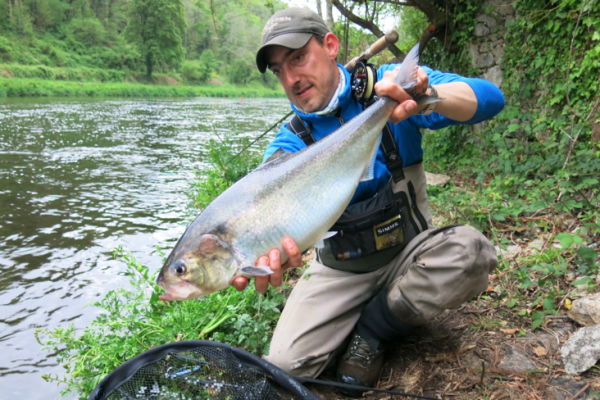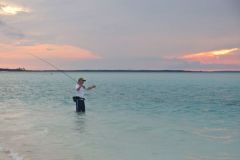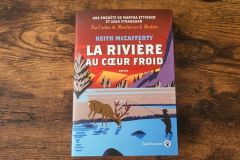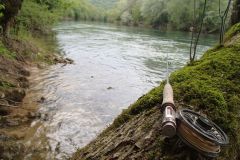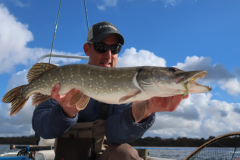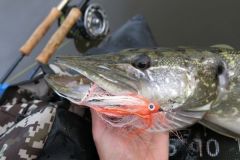With its extensive coastline, Brittany offers great potential for hosting migratory species, the best-known of which are of course salmon and sea trout. However, since the beginning of 2000, shad runs have increased, then stabilized over the last ten years, attracting many anglers in search of thrills and spills. Indeed, shad are a real sport fish, provided you take an interest in fishing them and adapt your equipment accordingly.
As early as March, the first shad are already showing the tip of their noses in many of Brittany's coastal rivers, especially those with canals, where the water warms up more quickly. But it's especially from early April, when water temperatures rise and spring sets in, that shad colonize certain Armorique rivers in greater numbers. There are over fifteen of them, ranging from medium-sized rivers such as the Odet, Elorn and Scorff, to larger, canalized rivers such as the Aulne, Blavet, Oust and Vilaine, where the majority of fishermen live.
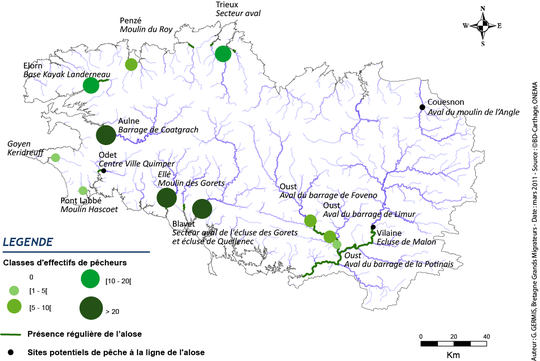
April, the start of the season
In Brittany, the first peak of the run usually occurs in April, with spring flows, and often coincides with a high tide. This is the time to get out your reservoir fly rod and try to catch the first arrivals, which are often very large, fresh and therefore very combative, violently bending the carbon.
At this time of year, very few anglers are specifically looking for them, although now some connoisseurs are eagerly awaiting their arrival in ever-increasing numbers. Then, gradually, in small groups, the shad will find themselves more and more abundant behind the first locks of Brittany's rivers, especially the Aulne in Finistère, the Blavet and the Oust in Morbihan, which, according to Bretagne Grands Migrateurs and to my knowledge, are the three rivers where fishing for this migratory fish is regularly practiced.
These rivers have all been canalized and fitted with locks for many years, which hinder the upstream migration of shad, even though each of them is equipped with an all-fish pass (salmon, sea trout, shad, lamprey). The latter are often temporarily blocked, depending on water levels, much to the delight of anglers.
While some of the troops have already arrived, most of the locks in Brittany are now bustling with the arrival of a few faithful anglers, who have come to cast their flies in the hope of catching this powerful and combative migratory fish.
For the moment, all you need is a fishing license, and there's no fee to fish for this species, unlike salmon and sea trout (which require a migratory stamp). Shad, when fresh from the sea, are very powerful and offer guaranteed thrills to anyone interested.
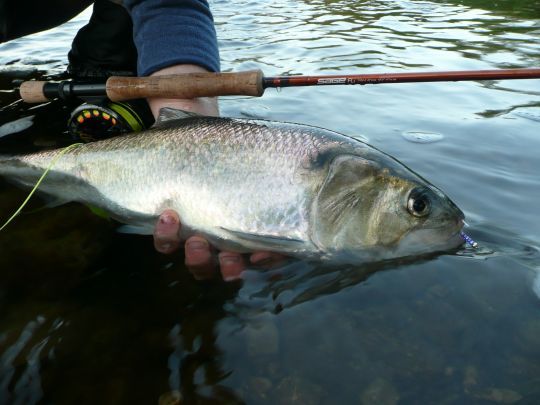
What equipment should I use?
In fact, with lightweight equipment, you can have a really good time and finally get some line or backing out! Rods of power 6 to 8 are best for 9 to 10 footers, for one-handed rod enthusiasts, or 10.6 to 12 footers for switch rods, which are perfect for wider spots. If you wish to fish throughout the shad season (from mid-April to the end of June), we recommend you use at least three line densities (floating with sink tip, intermediate and floating) or a multi-tip line (i.e. with interchangeable tips) for fishing in all conditions.
The technique remains quite similar to salmon fishing, which consists in combing the spots where the shad are holding, looking for the right water vein, depth, fly color and drift speed. For this species, it's essential to fish at the right level, and to be aggressive enough to get the bites.
At the very start of the season, in April or early May depending on water levels, a floating line with a plunging tip will allow you to fish "hollow" and present the fly at the right "stage". At this time of year, it's important to have very colorful models, of fairly large size (hooks 4 to 6) and to pass the fly fairly gently close to the bottom. Generally speaking, the touch occurs when the fly accelerates at the end of the "swing" and rises at the end of the drift. You can also animate your fly slightly to try to trigger a reflex bite, although most catches are made with an inert drift, for large shad. Their cousins, the feints, are much more receptive to rapid animation.
As the water gradually warms up in May, the fish become more active and move more freely. It's time to switch to a floating fly line with an intermediate tip. You'll need to consciously reduce the size of the fly (8 to 12), but keep colorful flies, generally imitating small shrimps or fish. My favorite patterns are orange, red, yellow, chartreuse green and purple.
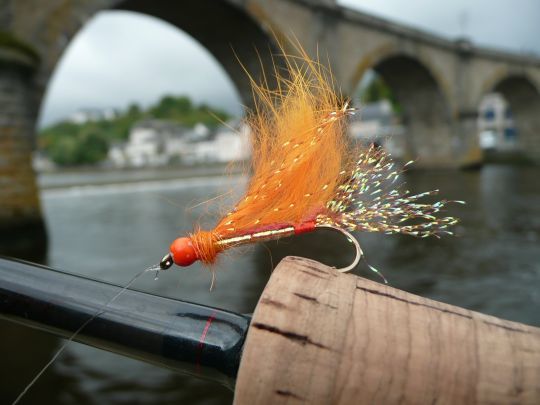
In May, do as you please!
May is certainly the best time of the year to catch your first shad, or if you're a regular, to have a great time catching several fish in a few hours. The best times of day are at dawn and dusk, as shad don't like strong light. It's also at these times that shad are more aggressive and get caught.
At this time, the shad are present in good numbers, as the upstream migration has been gradual and the stock is building up. A second peak in the shad run generally occurs between mid- and late May, once again with a high tide. They're active, very biting and always very cool. This is the month to give it a try, or if you're an enthusiast of this species, to focus on these interesting and entertaining fish to look for.
In May, the technique remains the same as at the start of the season, but fishing is generally lighter. Shad are more aggressive and move more in the water column. You need to comb the spots carefully, and not stick to the same area even if you've caught a fish in a particular spot. Shad move up and down in the currents and don't stay put. They gather and seek each other out to start preparing for their reproductive cycle, which can begin when the water is above 15°C (optimum 17°C). Unlike salmon, which often remain posted behind a boulder or in a pit, shad are constantly on the move. It is therefore advisable to cast far out to get a long drift and cover ground.
In many cases, you will need to make several mendings to get your fly down and slow the drift, although it is possible to catch shad in open water when they are very aggressive and with milder water temperatures. The most important thing, then, is to control your drift so that your fly goes where and how you want it to. You need to stay focused so as not to miss a single touch. These are often very violent and very dry, and if the hooking is not done instantly, it is rare to bite them as they quickly spit out the fly.
During the fight, let your shad make its first big rush, which is often the most powerful, then keep the pressure on and remember to lower the rod when your shad graces you with a few scabrous jumps. It's a pure delight! When landing your shad in the net, be careful, as they will fight you to the finish and often break or stall you at the last moment. Next, hold your shad just above the water if you want to take a few photos. Avoid handling it too much and return it quickly to the water. It's a very sensitive and vulnerable fish. This will enable it to reproduce and ensure its progeny.
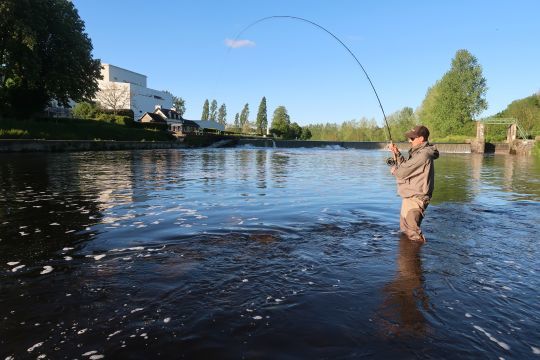
June, the season continues
As the season progresses and we approach June, many parameters are changing. Water levels drop and warm up, and the current slows down, implying changes in the water veins and a necessary adaptation in our fishing technique. The bulk of the shad have arrived, some of which have been in the river for some time, and their aggressiveness may be diminishing.
The first shad to enter in April are starting to "get the hang of it", or have been caught and are becoming less aggressive. We're also seeing more and more "bulls" (groupings of fish on the surface during spawning), and activity is at its peak in the evening, during the last 2 hours of the day. These "bulls" enable us to spot and locate the "attroupements". They can also be seen "rolling" on the surface, giving you an idea of their presence. That's where you have to keep your eyes peeled.
These changes will lead to changes in fishing technique. It's time to fish with floating silk and long leaders to adapt to the conditions. Fly size should be reduced (10 to 14), as water levels are often much lower and the current less powerful, so less or no mending will be needed to maintain an attractive drift. This time, it's advisable to animate your fly to trigger hits and, above all, to increase the speed of your fly if the current has become too slow.
You can use the technique very familiar to reservoir anglers, the "rolly polly", which consists of placing the rod under your armpit and pulling the line back with both hands in quick but short strips. Flies should be tied with more mobile materials (marabou, rabbit hair, craft fur) to create movement and a semblance of life. The "rolly polly" bites are lightning-fast and a real treat for the angler!

End of season
During June, the vast majority of shad have reproduced, although bulls can still be seen. Once the shad have reproduced, they quickly begin to tire and gradually die, exhausted and emaciated. Shad corpses can be seen here and there, notably in the grates of the structures and on the edges, reminding us that the end of the season is approaching. These will very slowly degrade and transform into organic matter, thus completing their life cycle.
Once hatched, the few-millimeter-long alosons will remain in their watercourse for a few weeks, before gradually drifting out to sea, spending some time in the estuary, a very rich ecosystem that will enable them to grow rapidly (to a size ranging from 40 to 70 mm) and gain strength before migrating to sea, where they will encounter many obstacles and predators.
In the case of the large shad, the majority of which are found in Brittany, females spend between 3 and 6 years at sea, while males have a slightly shorter stay of 2 to 5 years. While at sea, they feed on small fish, squid larvae, shrimps and other small prey, before returning to the river to complete their life cycle and delight numerous anglers!
